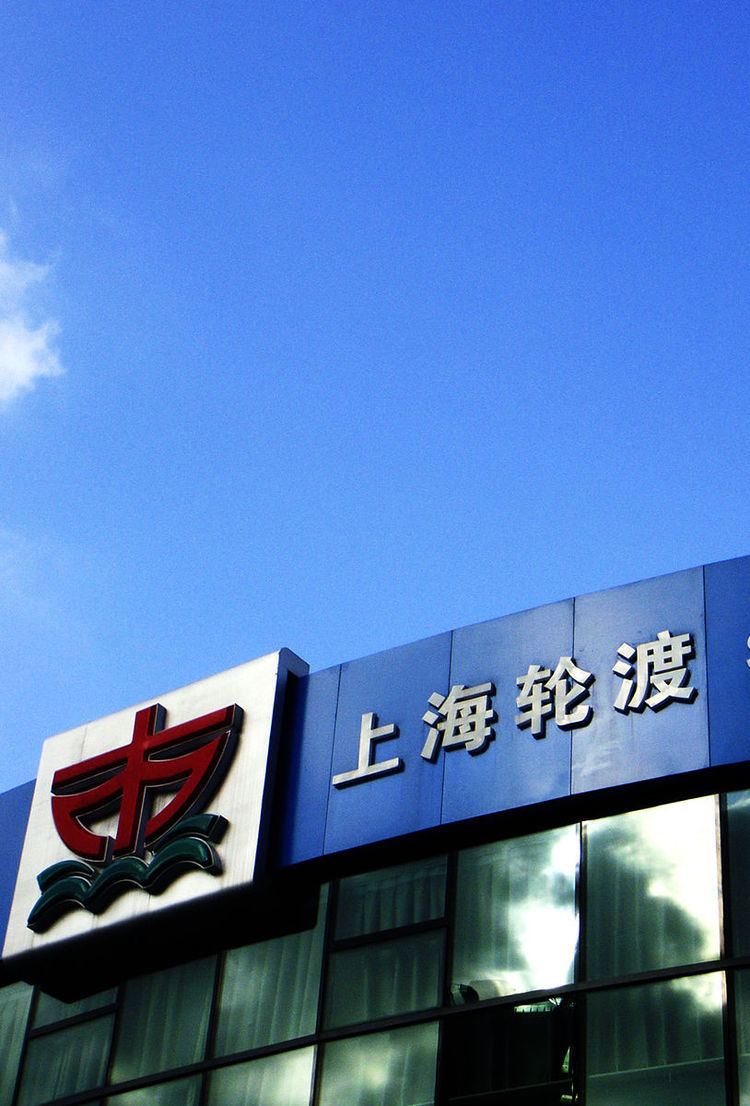 | ||
The Shanghai Ferry (Chinese: 上海市轮渡, abbr. 市轮渡) is a system of ferry routes across the Huangpu River in Shanghai. The ferry service started on January 5, 1911 by the municipal authorities in Pudong. Before the 1970s, the ferry service was the only way to cross the Huangpu River. In the 1980s, the Shanghai Ferry became one of the busiest ferry services in the world. In the 1990s, as bridges and tunnels across the Huangpu river were built, the ferry service saw a sharp drop in ridership. The Shanghai Ferry currently consists of 18 ferry lines and is operated by the state-owned Shanghai Ferry Company.
Contents
Before the creation of the ferry service
Before the Shanghai ferry service was created, private sampan ferries were the main way to cross the Huangpu River. Most sampan ferries could only carry around 30-50 passengers and a one-way trip across the river would take around 30 minutes. As the city grew, the demand for cross-river traffic increased rapidly. In addition, increasing number of large vessels and the strong currents on the river posed extra dangers for traditional sampan ferries. Accidents involving sampan ferries were on the rise.
In 1909, municipal authorities in Pudong dredged several tributaries of the Huangpu River. To help the workers commute across the river, the Pudong authorities rent a steamboat to ferry workers between the Tongren Pier (near the Bund at East Beijing Road) and Donggou in Pudong. Since the number of workers taking the ferry was far below the ferry's capacity, the authorities would also admit other passengers along the way, charging a small fee to subsidise the operation costs. As the steamboat was much safer and faster than other means to cross the river such as sampan ferries, taking the steamboat became the preferred way for people to cross the river. Meanwhile, the authorities realised that the ferry revenues can cover the renting cost. The authorities therefore decided to make its steamboat ferry service permanent.
Development of the ferry service
On January 15, 1911, the Pudong municipal authorities launched a ferry line between Tongren Pier and Donggou. In 1917, another ferry line linking Tongren Pier to Xidu was launched. Two years later, the authorities launched a ferry line between Tongren Pier and Xigou (Qingningsi). Around the same time, private ferry companies also started to launch commercial ferry lines.
In 1927, the ownership of the Pudong ferry service was transferred to the newly established Shanghai Special Municipality. By 1935, the ferry service operated 6 lines across the Huangpu river with 9 steel floating docks, 6 wooden docks, 12 ferry boats, and 5026 seats. The annual ridership reached 12.98 million. Before the Second Sino-Japanese War in 1937, the Shanghai Ferry, consisting of mainly government-run ferry lines as well as private ferry lines, became the main way to cross the Huangpu River.。
The Shanghai Ferry service was reduced to 3 lines due to the Second Sino-Japanese War. By 1945, the Shanghai ferry fleet had been reduced to 2 long ferries, both leased out, and 3 standard ferries unable to put in service due to broken engines. In March 1947, the Shanghai Ferry Company was established as a joint venture between the government and various private ferry companies and original ferry lines were being restored. By 1949, the Shanghai Ferry Company operated 4 ferry lines across the river, one long-haul ferry route, and one ferry route for automobiles with 19 ferry boats, 13 steel floating docks, and 2 wooden docks.。
Shortly after the Communist takeover of Shanghai, the military administration of Shanghai requisitioned the Shanghai Ferry Company on December 28, 1949. In 1956, the Communist government nationalised the ferry industry of Shanghai, abolishing traditional private sampan ferries and acquiring new ferry boats to launch new lines. In 1993, the Shanghai Ferry Company operated 21 lines with a daily ridership of 1 million and an annual ridership of 3700 million.。By 2011, the Shanghai Ferry Company operated 18 ferry lines and 55 ferry boats with a daily ridership of 250,000.
Discontinued Lines
In the 1990s, the Shanghai government built several tunnels and bridges across the Huangpu River, such as the Nanpu Bridge, the Yangpu Bridge, and the East Fuxing Road Tunnel. As a result, some ferry lines were discontinued due to sharp drops in ridership.
Fares
Shanghai ferry service has different fare categories for 8 types of passengers.。
Discounts
Discounts on Shanghai Ferry are available to holders of the Shanghai Public Transport Card. Ferry discounts are separate from other public transport discounts and standard ferry discounts are separate from air-conditioned ferry discounts. According to the website of the Shanghai Ferry company::
Accidents
The deadliest accident of the Shanghai Ferry happened on December 12, 1987. Heavy fog on that day resulted in a suspension of ferry service at Lujiazui Ferry Terminal, where passengers started to gather up. The ferry service restored at 9 am. When the second ferry arrived at 9:10 am, anxious passengers pushed towards the ferry boat. An estimated 30,000-40,000 passengers (many with bicycles) had queued for the ferry. The passengers became anxious from the waiting and began to push towards the second ferry, after the first had departed. People and bicycles began to fall into the river from the pushing and the scene quickly turned chaotic. The station was closed 5 minutes later in order to disperse the crowd and commence rescue operations.
The disaster killed 17 people, severely injured 2 and injured over 70 people. It was the deadliest stampede to occur in Shanghai before the stampede in 2014. Another casualty report stated that 66 were killed, 2 severely injured and over 20 slightly injured.
